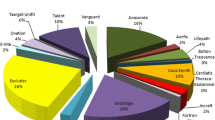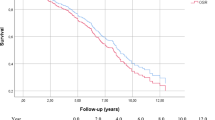Abstract
Background
The goal of the present study was to investigate the number of operations for abdominal aortic aneurysm (AAA) including time-trends in treatment during a 20-year period. Operating time and anesthesia time were also studied.
Method
During the period 1983–2002, a total of 1,041 patients with AAA were treated with open surgery (905) or EVAR (136). Number of operations, type of graft, anesthesia time, and operating time were the variables investigated. Data were collected retrospectively from the patients’ medical records.
Results
There was an increase in the number of operations both for ruptured and non-ruptured AAA in men during the study period. Among women, an increase was observed only for ruptured aneurysm. Operating time and anesthesia time increased significantly during the 20-year period. The number of patients treated by EVAR increased significantly, beginning in 1995.
Conclusions
In conclusion, there has been an increase in the number of AAA operations, and the proportion of patients treated with EVAR is increasing. Furthermore, we found an increase in both anesthesia time and operating time. These trends may be important for allocation of resources needed for the treatment of patients with AAA.



Similar content being viewed by others
References
Bengtsson H, Bergqvist D, Sternby N-H. (1992) Increasing prevalence of abdominal aortic aneurysms. A necropsy study. Eur J Surg 158:19–23
Haug ES, Romundstad P, Sæther OD, et al. (2005) Quality of data reported on abdominal aortic aneurysm repair—a comparison between a national vascular and a national administrative registry. Eur J Vasc Endovasc Surg 29:571–578
Greenhalgh RM, Brown IC, Epstein D, et al. (2005) Endovascular aneurysm repair and outcome in patients unfit for open repair of abdominal aortic aneurysm (EVAR trial 2): randomised controlled trial. Lancet 365:2187–2192
Brown LC, Powell JT. (1999) Risk factors for aneurysm rupture in patients kept under ultrasound surveillance. UK small aneurysm trials participants. Ann Surg 230:289–297
Solberg S, Singh K, Wilsgaard T, et al. (2005) Increased growth rate of abdominal aortic aneurysms in women. The Tromsø study. Eur J Vasc Endovasc Surg 29:145–149
Brewster DC, Cronenwett JL, Hallett JW, et al. (2003) Guidelines for the treatment of abdominal aortic aneurysms. Report of a subcommittee of the Joint Council of the American Association for Vascular Surgery and Society for Vascular Surgery. J Vasc Surg 37:1106–1117
Heller JA, Weinberg A, Arons R, et al. (2000) Two decades of abdominal aortic aneurysm repair: Have we made any progress? J Vasc Surg 32:1091–1100
Dillavou ED, Muluk SC, Makaround MS. (2006) A decade of change in abdominal aortic aneurysm repair in the United States: have we improved outcomes equally between men and women? J Vasc Surg 43:230–238
Semmens JB, Norman PE, Lawrence-Brown MM, et al. (2000) Influence of gender on outcome from ruptured abdominal aortic aneurysm. Br J Surg 87:191–194
Wainess RM, Dimick JB, Cowan JA Jr, et al. (2004) Epidemiology of surgically treated abdominal aortic aneurysms in the United States, 1988 to 2000. Vascular 12:218–224
Anderson PL, Gelijns A, Moskowitz A, et al. (2005) Understanding trends in inpatient surgical volume: Vascular interventions, 1980–2000. J Vasc Surg 39:1200–1208
Johansson G, Swedenborg J. (1994) Little impact of elective surgery on the incidence and mortality of ruptured aortic aneurysms. Eur J Vasc Surg 8:489–493
Haug ES, Romundstad P, Aune S, et al. (2005) Elective open operation for abdominal aortic aneurysm in octogenarians—survival analysis of 105 patients. Eur J Vasc Endovasc Surg 29:489–495
Lange C, Leurs LJ, Buth J, et al. (2005) Endovascular repair of abdominal aortic aneurysm in octogenarians: an analysis based on EUROSTAR data. J Vasc Surg 42:624–629
Crawford ES, Saleh SA, Babb JW 3rd, et al. (1981) Infrarenal abdominal aortic aneurysm. Factors influencing survival after operation performed over a 25-year period. Ann Surg 193:699–708
Acknowledgments
This work was supported by a grant from St. Olav’s Hospital, University Hospital of Trondheim, and The Medical Faculty, NTNU (Norwegian University of Science and Technology), Trondheim (1401 1023 4630).
Author information
Authors and Affiliations
Corresponding author
Rights and permissions
About this article
Cite this article
Berge, C., Haug, E.S., Romundstad, P.R. et al. Infrarenal Abdominal Aortic Aneurysm Repair: Time-trends during a 20-year Period. World J Surg 31, 1682–1686 (2007). https://doi.org/10.1007/s00268-007-9124-1
Received:
Revised:
Accepted:
Published:
Issue Date:
DOI: https://doi.org/10.1007/s00268-007-9124-1




